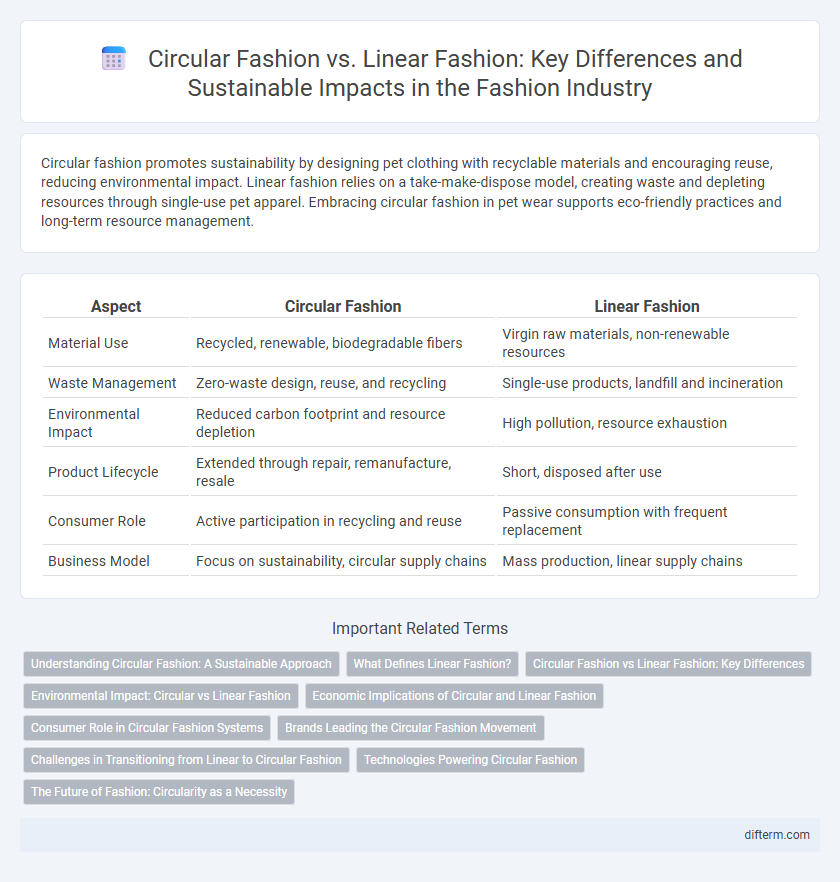Circular fashion promotes sustainability by designing pet clothing with recyclable materials and encouraging reuse, reducing environmental impact. Linear fashion relies on a take-make-dispose model, creating waste and depleting resources through single-use pet apparel. Embracing circular fashion in pet wear supports eco-friendly practices and long-term resource management.
Table of Comparison
| Aspect | Circular Fashion | Linear Fashion |
|---|---|---|
| Material Use | Recycled, renewable, biodegradable fibers | Virgin raw materials, non-renewable resources |
| Waste Management | Zero-waste design, reuse, and recycling | Single-use products, landfill and incineration |
| Environmental Impact | Reduced carbon footprint and resource depletion | High pollution, resource exhaustion |
| Product Lifecycle | Extended through repair, remanufacture, resale | Short, disposed after use |
| Consumer Role | Active participation in recycling and reuse | Passive consumption with frequent replacement |
| Business Model | Focus on sustainability, circular supply chains | Mass production, linear supply chains |
Understanding Circular Fashion: A Sustainable Approach
Circular fashion emphasizes the design, production, and consumption of clothing with the goal of minimizing waste and extending garment lifecycle through recycling, upcycling, and reuse strategies. This sustainable approach contrasts with linear fashion's take-make-dispose model, which contributes significantly to environmental pollution and resource depletion. Key principles of circular fashion include using biodegradable materials, implementing closed-loop supply chains, and encouraging consumer behavior that supports longevity and responsible disposal of apparel.
What Defines Linear Fashion?
Linear fashion is characterized by a take-make-dispose model that prioritizes rapid production and consumption of garments, often resulting in significant waste and environmental degradation. This system relies heavily on virgin resources and seldom incorporates recycling or reuse, leading to a one-way flow of materials from extraction to landfill. Brands operating within linear fashion typically emphasize trends and fast turnover, contributing to overproduction and short product lifecycles.
Circular Fashion vs Linear Fashion: Key Differences
Circular fashion emphasizes reusing, recycling, and repurposing materials to minimize waste, contrasting with linear fashion's take-make-dispose model that generates significant environmental impact. In circular fashion, products are designed for durability and end-of-life recovery, promoting sustainability and resource efficiency. Linear fashion prioritizes fast production and consumption, often leading to increased pollution and resource depletion.
Environmental Impact: Circular vs Linear Fashion
Circular fashion significantly reduces environmental impact by prioritizing resource reuse, recycling, and waste minimization, which lowers carbon emissions and conserves water and energy compared to linear fashion. Linear fashion relies heavily on raw material extraction and creates substantial textile waste, contributing to pollution and landfill overflow. Embracing circular fashion models enhances sustainability by extending product lifecycles and supporting eco-friendly production practices.
Economic Implications of Circular and Linear Fashion
Circular fashion drives economic sustainability by promoting resource efficiency, reducing waste, and fostering innovation in materials and production methods, ultimately lowering costs associated with raw material extraction and waste management. In contrast, linear fashion relies on a take-make-dispose model that generates significant economic externalities, including high environmental cleanup costs and resource depletion, which can increase long-term operational expenses. Embracing circular fashion models enhances economic resilience by creating job opportunities in recycling, repair, and remanufacturing sectors while supporting sustainable growth in the global fashion industry.
Consumer Role in Circular Fashion Systems
Consumers drive circular fashion systems by prioritizing sustainable choices such as purchasing secondhand, upcycling, and supporting brands with transparent recycling practices. Their active participation reduces textile waste and extends product lifecycles, crucial for minimizing environmental impact compared to traditional linear fashion's take-make-dispose model. Engaging in clothing rental, repair services, and mindful consumption shifts demand toward a regenerative ecosystem fostering resource efficiency and ethical production.
Brands Leading the Circular Fashion Movement
Leading brands in the circular fashion movement, such as Patagonia, Stella McCartney, and Eileen Fisher, prioritize sustainability by integrating recycled materials, offering repair services, and implementing take-back programs. These companies reduce waste through innovative design and production processes that extend garment lifespans, contrasting sharply with the wasteful practices of linear fashion models. Their commitment to circular principles not only minimizes environmental impact but also sets industry standards for responsible consumption and resource efficiency.
Challenges in Transitioning from Linear to Circular Fashion
Transitioning from linear to circular fashion faces significant challenges including supply chain complexity, high upfront costs, and consumer behavior shifts. Brands must invest in sustainable materials, develop efficient recycling technologies, and redesign products for durability and recyclability. Overcoming these barriers requires collaboration across industry stakeholders and regulatory support to foster a circular economy in fashion.
Technologies Powering Circular Fashion
Technologies powering circular fashion include advanced textile recycling methods, AI-driven design platforms, and blockchain for supply chain transparency. Innovations such as chemical recycling and 3D knitting enable the transformation of waste materials into new garments, reducing landfill impact. Digital tools enhance traceability, ensuring product longevity and facilitating resale or recycling within a closed-loop system.
The Future of Fashion: Circularity as a Necessity
Circular fashion prioritizes designing products for longevity, reuse, and recycling, reducing waste and minimizing environmental impact compared to the traditional linear fashion model of "take-make-dispose." Embracing circularity addresses resource scarcity and pollution by promoting regenerative systems, such as using sustainable materials, closed-loop production, and garment take-back programs. Industry leaders project that scaling circular practices could reduce fashion's carbon emissions by 45% by 2030, positioning circularity not just as an eco-friendly choice but an essential strategy for the future viability of the global fashion industry.
Circular fashion vs Linear fashion Infographic

 difterm.com
difterm.com